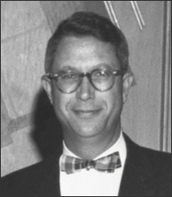|
C. W. "Bill" Harper died quietly on June 14 at the age of 92, after a stellar career in NACA and
NASA aeronautics. He was born September 24, 1913 in Winnipeg, Manitoba, Canada. His
family emigrated to the United States when Harper was in his pre-teens, moving first to Seattle
and then to Berkeley when he was in junior high school. He attended Berkeley High, graduating
in 1931.
Harper developed an interest in aviation while watching airplanes fly from Oakland airport. He
recalled seeing Charles Lindbergh land there in the early 1930s. This interest led him to enroll in
1936 at the Boeing School of Aeronautics at Oakland airport, a trade school set up by Boeing to
train employees for the rapidly expanding air transport industry. There he was exposed to early
airline operations, aircraft maintenance, and to his first taste of aerodynamics. A technical report
of the National Advisory Committee for Aeronautics (NACA) was the principal text for the
course, and it planted a seed in Harper's mind that would influence his career. Bill was soon
identified as an exceptional student, and after a year at the Boeing School he was encouraged by
his teachers to apply to the University of California at Berkeley in 1937 as a special student in
mechanical engineering. Harper found his niche at Berkeley and concentrated his studies on the
aeronautics option, graduating in June 1941.
Harper had aspirations to work at the newly formed NACA Ames Aeronautical Laboratory in
Mountain View. He was interviewed at Berkeley by Russ Robinson, who was involved in the
development of the Ames Laboratory and who went on to lead the aeronautics program there.
Harper's position at Ames was contingent on receiving U. S. citizenship, which was granted a
few months before the start of World War II. Harper embarked on his career at Ames
immediately after becoming a naturalized citizen. He was one of the first employees of Ames
who had not previously been an NACA employee in Virginia.
Harper began work in the 7- by 10-Foot Wind Tunnel under the leadership of Harry Goett. He
vividly remembered Goett giving him blunt counsel as a mentor to use his common sense in
interpreting data from tests in the tunnel. Harper was also heavily influenced intellectually by
sharing rooms for a year with H. Julian Allen. His first project was a powered model test of the
Douglas XSB2D-1 fighter prototype, seeking to understand the effects of power on directional
stability. He progressed in his assignments and shortly after completion of the Ames 40- by 80-
Foot Wind Tunnel became assistant chief of that branch. In 1948 when his boss, Harry Goett,
was elevated to the division level, Harper became Chief of the 40- by 80-Foot Wind Tunnel
Branch, where he led a group of engineers, mechanics, and computers in advancing the state of
the art for both civil and military aeronautical vehicles. (In those days, computers were people.)
In this position, he championed new research in boundary layer control and in powered-lift
STOL and V/STOL aircraft, and began to develop a partnership with Army aviation. It was at
this time that he encouraged two talented Ames aerodynamicists, Dean Chapman and Harvey
Lomax, to pursue analytical prediction of aerodynamic characteristics observed during wind tunnel
testing.
In 1959, Harry Goett was chosen to be Director of the newly formed Goddard Space Flight
Center. Once again, Harper followed in Goett's footsteps to become Chief of the 40- by 80-Foot
Wind Tunnel Division. While in this position, he expanded the V/STOL research program in the
40- by 80-Foot Wind Tunnel and in Ames flight research. Harper was an early proponent of
flight simulation, and he solidified and expanded that technology, taking advantage of rapidly
expanding computational capabilities. An early Ames simulation research program was the
development of the new six-degree-of-freedom simulator.
The challenges of the Space Age and the Apollo program resulted in some decrease of the
aeronautical research effort in NASA, but Harper was not content to allow that to happen. On the
day he took over the division, he was directed by NASA Headquarters to move all Ames flight
research to NASA's Flight Research Facility at Edwards Air Force Base. Harper showed the
necessity of linking flight research closely to the theoretical and experimental research in the 40-
by 80-Foot Wind Tunnel, preserving a role for flight research at Ames.
Harper's harassment of NASA Headquarters resulted in the ultimate penalty, Capitol
Punishment: in 1964 he was assigned to Headquarters as Deputy Associate Administrator for
Research and Technology for Aeronautics to bring a new sense of urgency to aeronautics and to
organize the program for advocacy to the Congress. His initial 18 month assignment stretched to
6 years. In this position Harper proposed and directed several bold new initiatives in
aeronautical research. He was able to help form research organizations for aeronautics and space
technology. He obtained NASA/Army agreement for collocation of Army research staff at the
NASA aeronautics centers, and for collaborative research in rotary-wing aircraft aeromechanics,
propulsion, and structures that would benefit both Army and civil aviation. He also initiated
advocacy for a similar agreement with the FAA, resulting in a program to develop certification
criteria for new classes of aircraft (such as supersonic transports and short takeoff and landing
aircraft) that would begin after his departure from headquarters. In 1968 Harper was selected by
the American Institute of Aeronautics and Astronautics to present the Wright Brothers Lecture.
His lecture anticipated future developments in computational fluid dynamics (CFD) and in flight
simulation, and forecast accurately the role they would play in complementing research both in
wind tunnels and in flight.
In 1970 Harper returned to Ames and retired from NASA shortly thereafter. However, his mind
never retired. He continued to consult for the FAA and DOE for several years after leaving
NASA. He kept up with the latest aeronautical research literally until his death, and acted as a
wise counselor on aeronautics matters to several government bodies as well as his many friends.
In recent times, he lamented once again the drift of NASA's attention away from aeronautics.
Harper continued to advocate aggressive development of simulation technology. Sadly, his
visionary proposals for improving airline safety and increasing simulation effectiveness for
accident investigation by the National Transportation Safety Board have not come to fruition.
Bill will be remembered by his friends and coworkers for his wise counsel, and for stimulating
them to attack problems that were on the frontier of knowledge and practice.
Bill will also be remembered for his love of life and of good friends, good food, good wine, and
the good life generally. He was fortunate to be married to Eleanor Vickers Harper for 47 years.
Vickie was an Ames mathematician, well known in her own right, and a great companion. They
were both enthusiasts of sailing, auto racing, wine and food, and jazz music. Vickie passed away
in 1997. |



